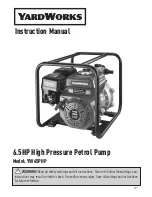
SECTION A: GENERAL INFORMATION
A-1) To the Purchaser:
Congratulations!
You are the owner of one of the finest
pumps on the market today. Burks® Pumps are products
engineered and manufactured of high quality components.
Over eighty years of pump building experience along with a
continuing quality assurance program combine to produce a
pump which will stand up to the toughest pumping projects.
This manual will provide helpful information concerning
installation, maintenance, and proper service guidelines.
A-2) Receiving:
Upon receiving the pump, it should be inspected for damage
or shortages. If damage has occurred, file a claim
immediately with the company that delivered the pump. If the
manual is removed from the crating, do not lose or misplace.
A-3) Storage:
Short Term -
Burks Pumps are manufactured for efficient
performance following long inoperative periods in storage.
For best results, pumps can be retained in storage, as factory
assembled, in a dry atmosphere with constant temperatures
for up to six (6) months.
Long Term -
Any length of time exceeding six (6) months,
but not more than twenty four (24) months. The units should
be stored in a temperature controlled area, a roofed over
walled enclosure that provides protection from the elements
(rain, snow, wind blown dust, etc.), and whose temperature
can be maintained b40 deg. F and +120 deg. F.
If extended high humidity is expected to be a problem, all
exposed parts should be inspected before storage and all
surfaces that have the paint scratched, damaged, or worn
should be recoated with a water base, air dry enamel paint.
All surfaces should then be sprayed with a rust-inhibiting oil.
A-4) Service Centers:
For the location of the nearest Burks Pumps Service Center,
check your catalog, your Burks Pumps representative or
Burks Pumps in Piqua, Ohio, telephone (937) 778-8947.
SECTION B: INSTALLATION RECOMMENDATIONS:
B-1) Location:
Locate the pump as close to the source of supply as possible.
Although the pump will operate on suction lifts of 25 feet, it
is desirable to keep the suction lift less than 15 feet, if
possible. The closer the pump can be located to the source
of supply, the faster the pump will prime and a greater
capacity can be pumped.
All pump units rotate clockwise when looking from the motor
end (driven end) of the pump. Also, rotation arrows are
located on the pump. On three phase units with threaded
suction/discharge connections the impellers are threaded on
the shaft and it is necessary to slide one half of the flexible
coupling back when checking rotation in order to eliminate
the possibility of unscrewing the impeller and damaging the
pump.
NOTE:
Where impellers thread on pump shaft, never
check the direction of electric motor rotation without first
disconnecting flexible coupling.
Locate the pump on a firm footing to make sure the pump will
not move due to vibration. Flex coupled and V-belt driven
units should be permanently grouted onto a cement
foundation. The pumps should be level to provide favorable
operating conditions. In addition, the flexible coupling should
be realigned after grouting in order to eliminate excessive
wear on the coupling.
Allow a minimum of 18 inches in front of the pump case cover
or hatch cover to permit easy removal and access to the
interior of the pump. On belt driven units, allow a minimum
of 10 inches at the shaft end to permit easy removal of the
pedastal or rotating cartridge.
B-2) Suction:
It is advisable to use a suction line of the same size as the
pump port size. All horizontal suction lines should slope up
to the pump to avoid trapped air pockets. An adjustable
stand, pipe clamp or floor flange must be installed to support
the weight of the suction line. On suction lifts less than 5 feet,
it is sometimes possible to increase capacity slightly by
oversizing the suction line, but oversized suction pipe on high
suction lifts will create priming problems. Using a smaller
suction line than the pump port size can cause internal
damage to the pump.
The suction line must not have holes, even small holes. The
smallest air leak in the suction line may prevent the pump
from priming. Coat all threaded connections in the suction
line with pipe thread compound to insure an air tight joint. In
addition, suction flanges should be pulled up tight to prevent
air leaks. Where fiber gaskets are used, coat them with
grease.
5
Summary of Contents for burks pumps WB12
Page 8: ...FIGURE 3 8 ...






























